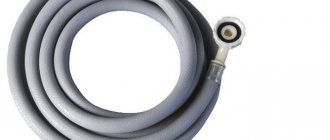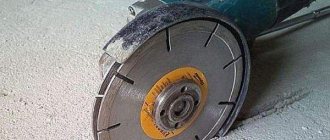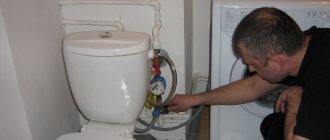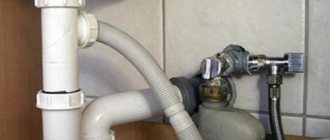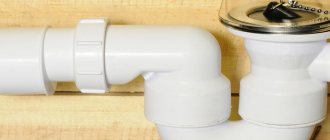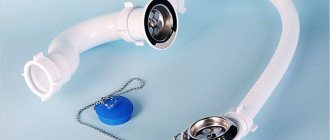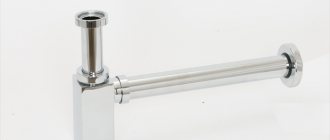Connecting a machine to the sewer system remains a hot topic, as many still solve it in different ways. Some pour the waste liquid from the machine into sinks, others into the toilet, bathtub or shower trays. Owners who have carefully read the manufacturer's technical instructions drain the water into the sewer using a washing machine siphon.
Purchasing a modern machine gun is not an ordinary event for many families. Having such a unit, washing will take much less time. There will be an opportunity to spend the freed hours on other useful and enjoyable things. But do not forget that for subsequent operation of the equipment, dirty water must be drained into the sewer.
Draining dirty water into the sewer through a siphon
Connecting the washing machine drain
Siphon - element of the connection system
How to properly connect a washing machine
The washing machine hose is connected to the siphon
Purpose of siphons
The purpose of this device is not only to limit access to the room of the disgusting smell from the sewer pipe. Siphons for draining liquids have many more functions:
- Protection against putrefactive and pathogenic bacteria formed from the decay of organic waste;
- Prevents the penetration of sewer odors and noise from this system thanks to a water seal;
- Preventing clogging and clogging of the sewer with debris that enters the pipe with water;
- Easy and simple access for cleaning as needed;
- Simplify the operation of the water pump due to a short hose.
The absence of a drain siphon in a washing machine can bring a lot of additional worries. It is partially possible to get away from them if you hang the drain hose at a height in a curved form and connect it to the sewer, creating a water seal, but this will require its extension. This method will only eliminate the depressing smell, so this path is considered incorrect. In addition, the outlet of the sewer pipe to create an air gap must be located quite high, at least 500 mm above the floor, which does not look aesthetically pleasing.
Theory
What is it needed for
During washing, the siphon processes the water that comes from the tank to drain through the drain hose. There are at least three more functions, the absence of which you will definitely feel:
- The device creates a water seal - a water plug between the bathroom and unpleasant odors from the sewer. The plug blocks the desired area in the pipe along its entire diameter, hermetically closing the passage of foul-smelling gases, even when the machine does not drain the water.
- At the same time, the spare part practically eliminates traffic jams in the system itself - and if a problem does occur, it allows you to easily fix it. Some models filter out large debris - coins, receipts, pins, buttons, rings, hairballs. This reduces the likelihood of sewer blockages to zero and helps to find the loss.
- The siphon reduces the load on the pump, which keeps the part in working condition much longer.
Often the drain hose is connected directly to the sewer or other drains - to the bathroom, sink or toilet. Connecting like this all the time is useless and dangerous:
- The hose will not create a water seal on its own; the pipe will have to be bent into an S or U shape.
- If you connect the hose directly to the sewer, you will not get rid of odors, and the corrugated casing will quickly become unusable under stress.
- The resulting “pump” often has to be expanded, because a sealing plug is not created in short pipes. This increases the load on the hose, and a leak may begin at the attachment point.
In general, the hose should only be used directly for short periods of time and in extreme cases. It is much safer and quieter to install a siphon.
Which one is better to choose?
The most popular brands are Bonomini, McAlpine, ITAP (ITAP), TECE, Alcaplast, Geberit, Grohe, RBM, Viega and ANI Plast. There is no clear solution for choosing a siphon. You can only compare each of the proposed types and choose a more suitable option for your apartment. We will discuss all types below.
Operating principle and device
A siphon is a useful and necessary invention that eliminates the additional hassle of sewer maintenance and reduces the load on the pump. It’s not for nothing that experts say that it is needed, since the product is structurally designed to create a water seal. A siphon is a pipe with a curved channel filled with a certain amount of liquid, which reliably blocks the exit of gases after draining the wastewater into the discharge system . The constant presence of a water plug in this product blocks the access of everything unnecessary (odors, insects) from the sewer network.
Siphons are used to connect washing machines to the drainage system; in addition, using these products you can connect sinks, showers and other equipment. These devices are usually made of plastic, as it does not rust. Sometimes they are made of brass and even copper; such materials are also not subject to corrosion, but over time they become covered with an oxide film.
Built-in siphon
Separately placed siphon
Siphon for double sink with outlet for washing machine
Built-in chrome siphon
Built-in block with outlet for connecting a hose from the machine
Checking the functionality of the equipment
When checking equipment, you need to pay attention to the following aspects:
- all fasteners must be tightened as tightly as possible;
- if the hoses have seams and joints, there should be no gaps between them;
- where the siphon connects to the drain hole, all bolts and nuts must be tightened especially tightly, because this is where leaks most often form.
In order to identify leaks, you should use toilet paper or paper napkins. The paper is placed at the seams and joints. Next, the washing machine starts. If the paper is wet in some places, it means it is leaking, and to solve this problem you need to tighten all the fasteners more tightly.
Connection rules
The pumps of a number of models of automatic machines are low-efficiency; during installation, it is not advisable to lengthen the drain hose installed by the manufacturer. You can connect the equipment to the siphon by simply pulling the hose onto the outlet pipe or using a union nut. And yet, despite the supposed simplicity, it is necessary to adhere to rules, failure to comply with which can create an emergency situation. Connecting the drain is only possible if the siphon is located at a height exceeding 800 mm above the level of the installation site.
Operation of the pump in this case is difficult, which can lead to premature failure of the pump. The manufacturer does not recommend extending the drain hose if for some reason the length is insufficient. To avoid overloading the pump, it is proposed to lay an additional sewer pipe of small diameter, this will allow the pump to operate without difficulties .
If there are no options other than extending the hose, it is secured so that there is a slope towards the sewer pipe, and the liquid can flow by gravity. Usually the instructions describe this in detail; in the absence of recommendations, you need to remember that the open end of the drain pipe should be located at a height of no more than 60 cm from the floor level.
Kitchen
Installing a siphon in the kitchen is both simple and complex. Simple - because the pipe and sink are quite easily accessible. Complex - because the required kitchen siphon can be a rather complex design. A washing machine requires a siphon with an additional fitting. If the kitchen also has a dishwasher - with two. For a double sink, you will need a siphon with a double drain.
Kitchen siphons
In addition, in new houses the sewer pipe is located on the wall and goes directly into the riser; In this case, there are several risers per apartment. From the point of view of sanitation and hygiene, this is excellent, but the release of the siphon will no longer go down, but back or sideways. Some types of kitchen siphons are shown in the figure; Using the diagram on the left you can calculate the size of the free space for the siphon.
Instructions for installing a siphon in the kitchen
- Check the fit of the drain grate in the sink sink. It may turn out that the stamping in the sink is too shallow. This is unacceptable: the puddle around the protruding grille will quickly become a breeding ground for infection. In such a case, it is advisable to agree with the seller about a replacement when purchasing. As an extreme option, install the grate without a gasket, on a sealant.
- We place an installation collar lubricated with sealant into the sewer pipe. The installation surface of the pipe must be dry.
- We check the end (joining) surfaces of the body threads. Using a sharp knife, cut off burrs and flash (they can damage the gaskets) and use it or a scraper (reamer) to remove chamfers of 0.5-1 mm.
- If necessary, cut the outlet end of the drain pipe to size, insert it into the cuff, and secure it. If the fastening is with a clamp, you will need a screwdriver to tighten the clamp screw. The threaded end of the outlet pipe should face the body of the siphon (bottle or elbow).
- If the spout goes down, place a square on the upper end of the outlet pipe on the sealant.
- We install a drain grate in the sink sink. We are not installing the bottom black rubber gasket yet.
- We place a thin ring gasket in the groove of the plug and lubricate it with sealant, covering the root part of the thread by 2-3 turns. We wrap the cork.
- Insert a valve into the outlet pipe of the bottle, if provided. The valve flap must open outwards.
- We connect the siphon bottle to the outlet pipe: place a conical outlet gasket on the sealant with the narrow end to the bottle, insert it into the bottle, and screw the side nut of the bottle onto the thread. We don’t tighten it too tight.
- We place the lower drain gasket in the groove of the upper pipe of the bottle on the sealant, bring it to the drain pipe of the drain grate, and loosely tighten the upper nut of the bottle.
- Rocking the bottle slightly, alternately tighten the top and side nuts of the bottle tightly.
- If the fittings of the washing machine and sink are not yet used, we plug them with rubber plugs, complete or suitable in size. Otherwise, we simply pull the drain hoses onto them.
About the valve
In the case of a flood, even an unkempt, slimy valve can save the apartment: it can be dealt with by general cleaning rather than repairs. But the valve becomes overgrown with sludge, so the siphon with the valve must be periodically disassembled and cleaned. That's why:
- On the top floor, or in new houses with separate risers, the valve is not needed at all: there is no one to fill it and/or it is impossible.
- In 97% of cases, when the sewage system is unbroken, the first floor is flooded. Here a valve is necessary in any case.
- In other cases, be guided by the neighbors BELOW: how neat, respectable and prone they are to illegal amateur activities, such as installing a catcher pin in a riser.
Installation Features
Owners of small rooms sometimes have to place equipment under the sink, the dimensions of which should overlap the dimensions of the machine, so that moisture in the form of drops or splashes does not fall on the equipment. In this case, the siphon is selected in a vertical configuration, which will allow the equipment to be placed as close to the wall as possible. This type of product is supplied assembled by the manufacturer. The owner only needs to install it in the socket of the outlet network, where the O-ring is located. As you can see, the installation of the device is quite simple; manual installation will save money. The main disadvantage is that the machine must be located close to the sink.
Sink above the washing machine with a common siphon
Mini machine under the sink
Washbasin with flat bottom for installation above the car
Tandem washing machine and sink
In a small bathroom, the washing machine is often placed under the sink
How it works?
The illustration shows two types of siphons:
- The classic tubular version has been used for many years. In Soviet-built houses you can find a cast iron elbow of this shape. The principle of operation is as follows: there is always liquid in the lower elbow, creating a water seal. Thanks to this, unpleasant-smelling air does not enter the room from the sewer. But such “elbows” do not interfere with the drainage of water.
- Modern bottle siphon. The design is more compact without losing functionality. Water flows freely, but no air enters.
The toilet flush path has a similar shape, it’s just not as noticeable. The structure is located inside.
Installation stages
An automatic washing machine is an expensive piece of equipment; when installing and operating it, follow the manufacturer’s instructions. The higher the cost of the product, the greater the cost of repairs.
Installation of a siphon with outlet
A siphon for a washing machine for draining waste liquid into the sewer looks exactly the same as for a sink, the difference lies in the presence of a separate pipe on it, to which the machine is connected. Installation is carried out in the same way as it is done for a sink in the kitchen or a washbasin in the bathroom. Sometimes it is not the sink siphon itself that is replaced, but only the tube with the fitting, but this option is undesirable.
The step-by-step process looks like this:
- We remove the old device by unscrewing the two plastic nuts securing it to the sink and drain. At the same time, do not forget to place a container into which dirty water from open holes will drain;
- We clean the sink outlet into the sewer, removing accumulated dirt and adhering deposits;
- We install a new siphon, tightening both nuts tightly;
- We put the hose from the washing machine on the fitting intended for it;
- We tighten the connection with a pre-prepared clamp, creating a tightness.
Installation of a built-in product
When carrying out renovation work in the bathroom, you need to provide a way to connect the washing machine to the sewer. If a permanent place is allocated for equipment, then a special siphon is built in to drain water. Then the installed product is covered with moisture-resistant plasterboard, on top of which tiles are glued, leaving a small outlet outside for connecting the washing machine hose. Fastening is carried out by simply putting it on or tightening it with a nut. Such siphons are good because the distance between the wall and the machine is minimal, and the connection looks aesthetically pleasing.
A siphon for water drainage will protect the pump from excessive loads and protect against the harmful effects of sewage.
Removing the old siphon
Installing a new siphon with outlet
We put the hose on the outlet
Connect the washing machine hose to the siphon pipe
Built-in siphon on the wall
Built-in siphon under the bath
Preparing to purchase fittings
To organize an effective washing process, you can use any type of siphon. The main thing is to take into account ease of installation, use and aesthetic qualities. If the washing machine is located far from the siphon, and saving space is not an issue, then you can buy any type of siphon.
It is ideal when the drain fittings are hidden from view by something - a bathtub, sink, door, furniture, or any other object. If the shape of the siphon “hurts the eye”, does not add aesthetics to the room, and there is no way to hide it, then you need to purchase a built-in product.
This solution will allow you to place the washing machine close to any wall the owner needs and hide the drain fittings. This option will significantly improve the appearance of the room.
A combined siphon is the most universal solution, as it allows you to connect any number of drain hoses to the sewer pipe
When you plan to install it under a water lily sink, then it would be correct to purchase a flat siphon. It takes up a minimal amount of space, so you can easily accomplish your plans.
If a potential buyer plans to drain contaminated water from 2-3 types of equipment simultaneously, then the optimal solution would be to purchase a combined siphon that has the required number of fittings for connecting drain hoses.
If there is no check valve in the design of the washing machine, you should not save money on its purchase. The owner will not regularly benefit from it, but in a critical situation this product will save you from significant troubles and losses.
A flat siphon is the best option when the owner of a washing machine needs to save space in the bathroom or other room
There is no need to skimp on the quality of the siphon itself or its components. Since their service life is always relatively short, and budget options remain operational for an even shorter period of time.
